|
Introduction
The Ministry of Foreign Affairs (MOFA) of the Republic of China (Taiwan) has not only inherited a fine diplomatic tradition that began with the nation’s founding, but also accumulated a vast quantity of precious historical documents that dates back to the establishment of the Tsung-li ya-men (Office of Foreign Affairs) in 1861. MOFA’s impressive archives include more than 3,000 treaties, agreements, contracts and regulations, 615 boundary and site maps, and over 180,000 volumes of other documents that faithfully record the turbulent progress the Republic has made in its quest for diplomatic equality and independent sovereignty.
With this glorious tradition behind them and guided by the current policy of ‘viable diplomacy’, the entire staff at MOFA works diligently to expand Taiwan’s bilateral relations and international participation. They are helping to shape the Republic of China into a peacemaker, a provider of humanitarian aid, a promoter of cultural exchange, a creator of new technology and business opportunities, a standard bearer at the leading edge of Chinese culture, and a nation that is both respected by and inspiring to people around the world.
On the auspicious occasion of the centennial of the Republic of China, MOFA has carefully sorted through its archives and, with the National Palace Museum, coorganised A Century of Resilient Tradition: Exhibition of the Republic of China’s Diplomatic Archives. The exhibition falls into five sections: Lessons of History, Striving for Equality, Retrocession of Taiwan, Era of Resilience, and Diplomatic Legacy. On display are 88 items, including treaties, maps and documents, together with three charts: List of Ch’ing Treaties and Agreements Preserved by the Ministry of Foreign Affairs of the Republic of China, List of Ministers of Foreign Affairs of the Republic of China, and Countries /Territories Granting Visa Waivers or Landing Visas to ROC Passport Holders. Rare photographs are also on display to highlight the relevant moments in history.
We hope the exhibition will enable people from all walks of life in Taiwan, as well as friends from abroad, to better appreciate the history of the nation’s diplomatic efforts, which were made out of a belief in freedom and equality, as well as the significance of these invaluable documents. It is also hoped that, with its fine diplomatic tradition and resources, the nation will go on to make even greater achievements through its latest approach to foreign affairs: viable diplomacy.
Lessons of History
The Republic of China was born out of the weakness of the Ch'ing Empire, as well as invasion and repression by foreign powers. In his book, Fundamentals of National Reconstruction , Dr. Sun Yat-sen wrote,'I made up my mind to overthrow the Ch'ing Empire and establish a republic after we lost the 1885 Sino-French War. 'In his last will and testament, he urged his fellow citizens to make' abrogating the unequal treaties' their top priority.
The Ministry of Foreign Affairs keeps in its archives the originals of some 173 treaties, agreements, contracts and regulations concluded during the late Ch'ing period, which are listed in the chart.
Among the treaties selected for the exhibition are: the Treaty of Nanking signed between China and Great Britain in 1842, the earliest of the unequal treaties; the Treaty of Peace, Friendship and Commerce signed between China and France in 1885, which inspired Dr. Sun Yat-sen to launch a revolution; the Final Protocol of 1901, which had the largest number of signatories and the biggest indemnity; and the Burlingame Treaty signed between China and the United States in 1868, which was signed in proxy by an American. On display are 25 treaties and documents, and 12 relevant boundary or site maps.
Most of the treaties and agreements signed by the Ch'ing Empire were unequal. The signatories included Russia, Germany, France, Great Britain, the United States, Japan, the Netherlands, Portugal, Spain, Italy, Austria-Hungary, Belgium, Switzerland, Sweden, Peru, Denmark, Brazil, Mexico, Congo, and Korea. It demonstrates how formidable a task the Republic of China's diplomacy was right from the very beginning. Diplomatic breakthroughs could only be achieved by removing the heavy shackles of history.

|
Treaty of Nanking between China and Great Britain
Treaty signed: 1842/8/29
Location: Nanking
33.7 × 21.7 cm |
The first unequal treaty signed by the Ch'ing Court in the wake of the Opium War, with, among others, reparations and the cession of Hong Kong to Great Britain.

|
Convention of Peking between China and Great Britain
Treaty signed: 1860/10/24
Location: Peking
32.3 × 20.4 cm |
The treaty signed as the result of the Second Opium War, with the cession of Kowloon Peninsula to Great Britain.

|
Convention of Peking between China and France
Treaty signed: 1860/10/25
Location: Peking
31.8 × 21 cm |
One of the two treaties signed as the result of the Second Opium War that leads to the establishment of Tsung-li ya-men (Office of Foreign Affairs).
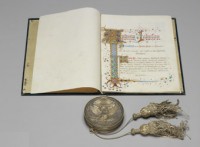
|
Additional Articles to the Treaty between China and the United States, of the 18th of June 1858 (Burlingame Treaty)
Treaty signed: 1868/7/28
Location: Washington, D.C.
36.7 × 27 cm |
The first relatively equal treaty in the late Ch'ing dynasty that was signed in proxy by the outgoing American Minister to China, Mr. Anson Burlingame, commissioned by the Ch'ing Court.
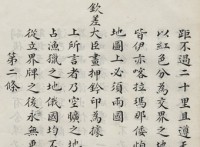
|
Convention of Peking between China and Russia
Treaty signed: 1860/11/14
Location: Peking
35.8 × 23 cm |
The treaty resulting in the Amur Annexation, in which parts of Outer Manchuria were ceded to Russia.
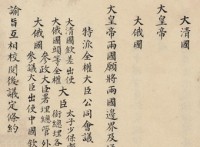
|
Treaty of Livadia between China and Russia
Treaty signed: 1879/10/2
Location: Livadia
34.5 × 22.3 cm |
This treaty, not ratified by the Ch'ng Court, cedes vast expanses of land west of Ili and along the Tekes River to Russia upon the return of Ili.

|
Map of the Second Sino-Russian Demarcation of the Northwestern Borders
1879/10/2
115 × 80 cm |
Map attached to the Treaty of Livadia.
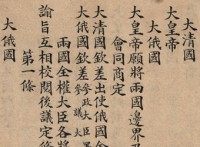
|
Treaty of St. Petersburg between China and Russia
Treaty signed: 1881/2/24
Location: St. Petersburg
33.6 × 21.5 cm |
One of the few diplomatic successes of the Ch'ing Court in which the eastern part of the Ili Basin is retroceded.
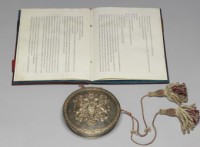
|
Agreement of Chefoo between China and Great Britain
Treaty signed: 1876/9/13
Location: Chefoo
32.7 × 19.7 cm |
The agreement that concedes Great Britain privileged access to Yunnan and Tibet.
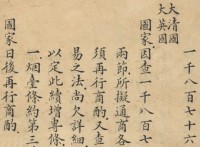
|
Additional Articles to the Agreement between China and Great Britain at Chefoo on the 13th of September, 1876
Treaty signed: 1885/7/18
Location: London
38.3 × 24.2 cm |
The originating article that exempts inland duties on imported goods into China.

|
Treaty of Peace, Friendship and Commerce between China and France
Treaty signed: 1885/6/9
Location: Tientsin
36 × 22.7 cm |
The treaty in which the Ch'ing Court forfeits its suzerainty over Vietnam to France, which inspires Dr. Sun Yat-sen to pursue revolutionary course against the Ch'ing Empire.
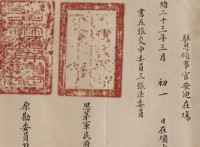
|
Demarcation Records of the Yunnan-Annam(Vietnam) Boundary between China and France
Treaty signed: 1896/10/25
Location: Bảo Thắng
31.7 × 22 cm |
The demarcation records that define the boundary between Yunnan and Vietnam after the Ch'ing Court forfeits its suzerainty over Vietnam to France.

|
Treaty of Amity and Commerce between China and Portugal
Treaty signed: 1887/12/1
Location: Peking
41.2 × 26 cm |
The treaty in which the Ch'ing Court concedes to transfer, in perpetuity, Macau's administrative rights to Portugal.

|
Map of Macau
1909
63 × 41.5 cm |
A map that illustrates the Portuguese infringement upon the territories beyond Macau's borders into Kuangtung Province.

|
Map of Macau
1910/1/20
79.4 × 64.1 cm |
The reference map used by the Ch'ing Court for negotiations with Portugal on the boundary of Macau.

|
Illustrated Description of Macau Boundary
Late Ch'ing or early years of the Republic of China
102.4 × 57 cm |

|
Map of Southern Tibet Boundary
1887
94.5 × 188.3 cm |
The map that depicts the British inroads entering southern Tibet during the late Ch'ing Dynasty.

|
Sikkim-Tibet Convention between China and Great Britain
Treaty signed:1890/3/17
Location: Calcutta
60.5 × 75.7 cm |
The first unequal treaty regarding Tibet in which the Ch'ing Court forfeits its suzerainty over Sikkim to Great Britain.
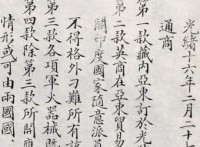
|
Regulations regarding Trade, Communication, and Pasturage to be appended to the Sikkim-Tibet Convention of 1890 between China and Great Britain
Treaty signed:1893/12/5
Location: Daijeeling
60.5 × 75 .7 cm |
The second unequal treaty regarding Tibet which grants trading rights to the British in Tibet.

|
Convention respecting Tibet between Great Britain and China
Treaty signed:1906/4/27
Location: Peking
40.9 × 30.9 cm |
The third unequal treaty regarding Tibet which grants the British exclusive rights on mining, trading, and land ownership in Tibet.
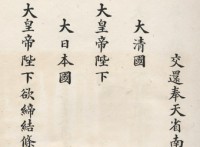
|
Convention for Retrocession of Southern Portion of Fengtien Province (Liaotung Peninsula) between China and Japan
Treaty signed: 1895/11/8
Location: Peking
32.7 × 22 cm |
The Ch'ing Court, in the wake of the Tripartite Intervention, pays an additional 30 million taels of silver to Japan to retrocede Liaotung Peninsula, originally ceded to Japan under the Treaty of Shimonoseki.
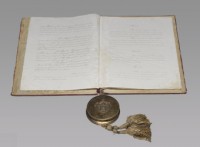
|
Li-Lobanov Treaty
Treaty signed: 1896/5/22
Location: Moscow
32.3 × 21.9 cm |
A secret treaty that, among others, permits the construction of Chinese Eastern Railway in Manchuria by Russia.
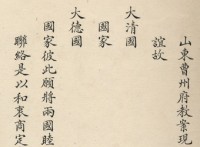
|
Convention respecting the Lease of Kiaochow between China and Germany
Treaty signed: 1898/3/6
Location: Peking
33.3 × 21.3 cm |
The convention that concedes to Germany railway building and coal mining rights in Shantung Province and thus consolidates German influence in Shantung.
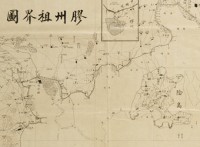
|
Map of Concession at Kiaochow
1914/8
117.8 × 138 cm |
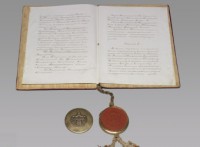
|
Treaty for the Lease of Liaotung Peninsula between China and Russia
Treaty signed: 1898/3/27
Location: Peking
44.8 × 33 cm |
The treaty that expands Russian influence from Northern to Southern Manchuria.

|
Map of Concession at Liaotung Peninsula (facsimile)
1912/8
49 × 295.2 cm |

|
Map of Liaotung Peninsula
1904/12
81 × 113.8 cm |

|
Convention for an Extension of Hong Kong Territory between China and Great Britain
Treaty signed: 1898/6/9
Location: Peking
32.9 × 21.3 cm |
The treaty that leases New Territory to Great Britain for 99 years.
![Map of the Extension of the British Concession at Sun-on [Hsin-an] Hsien, Kuangtung Province](http://culture.teldap.tw/culture/plugins/content/fboxbot/thumbs/diplomatic29_200x147_052dbe2bb0cf301cbb0ff1ad09010ac5.jpg)
|
Map of the Extension of the British Concession at Sun-on [Hsin-an] Hsien, Kuangtung Province
Late Ch'ing
67.5 × 96 cm |

|
Maritime Map of Hong Kong
Late Ch'ing or early years of the Republic of China
34.6 × 31 cm |

|
Convention for the Lease of Weihaiwei between China and Great Britain
Treaty signed: 1898/7/1
Location: Peking
32.8 × 20.7 cm |
The convention that grants Great Britain partial control over Bohai Gulfthe gateway to Northern China.

|
Map of Concession at Weihaiwei, Shantung
Late Ch'ing or early years of the Republic of China
48 × 56.3 cm |
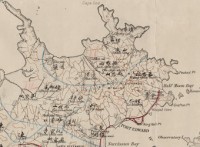
|
Map of Weihaiwei
1908/1
78 × 115 cm |

|
Convention between China and France relative to the Concession at Kuang-Chou-Wan
Treaty signed: 1899/11/17
Location: Kuang-Chou-Wan
27.5 × 22 cm |
The convention that consolidates French influence in Southern China via the mandatory lease of Kuang-Chou-Wan.
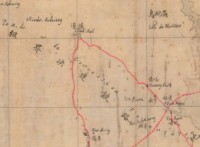
|
Map of Concession at Kuang-Chou-Wan
1899/11/16
54.5 × 69.7 cm |
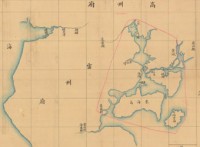
|
Map of Kuang-Chou-Wan, Kuangtung Province
Late Ch'ing or early years of the Republic of China
43.5 × 57.8 cm
|
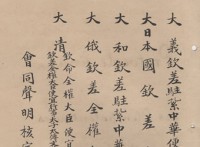
|
Final Protocol of 1901 (Boxer Protocol)
Treaty signed: 1901/9/7
Location: Peking
35.2 × 28 cm |
The unequal treaty resulting from the Boxer Rebellion, with the most signatories and largest reparations in Chinese history.

|
Agreement relative to Manchuria between China and Russia
Treaty signed: 1902/4/8
Location: Peking
34.1 × 28 cm |
An agreement in which Russia, under international pressure, withdraws from Manchuria.
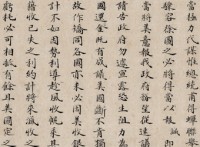
|
Documents on the Returning to China of the Boxer Rebellion Indemnity Paid to the United States
Period: 1905-1909
26.7 × 21.2 cm |
The origin and source of funding for Tsing Hua University.

|
Sino-Russian-Mongolian Agreement
Treaty signed: 1915/6/7
Location: Kyachta
40.1 × 29.7 cm |
The treaty that makes Outer Mongolia a Russian sphere of influence.
Striving for Equality
The Republic of China (ROC) took part in both World Wars, contributing to the allied war effort at a heavy cost. Through the hard work of our diplomats, Dr. Sun Yat-sen's last will and testament – to have the unequal treaties abrogated – was finally realised.
This section starts with the unequal Sino-Japanese Treaty of 1915, concerning Shantung Province, which led to the 'May Fourth Movement' immediately after World War I. Telegrams from the ROC Delegation to the Paris Peace Conference, where Minister of Foreign Affairs Lou Tseng-Tsiang refused to sign the Treaty of Versailles, are also on display.
Due to the efforts of the Ministry of Foreign Affairs, the ROC first abrogated consular jurisdiction and regained tariff autonomy from foreign powers through the Sino-German Agreement, the first equal treaty, signed in 1921.
In 1922, the United States, Belgium, Great Britain, France, Italy, Japan, the Netherlands and Portugal signed the Nine-Power Treaty with China, agreeing to respect ROC's sovereignty, independence, and territorial and administrative integrity. This laid the foundation for a series of other equal treaties, including the Agreement regarding the Rendition of the Belgian Concession in Tientsin of 1929, and the Sino-British Convention for the Rendition of Weihaiwei of 1930.
The United States and Great Britain both signed equal treaties with the ROC on January 11, 1943, prior to the end of World War II, to replace the old unequal ones. Nine countries – Belgium, Norway, Canada, Sweden, the Netherlands, France, Switzerland, Denmark and Portugal – soon followed suit. The government proclaimed January 11 as 'Justice Day' to celebrate the fact that, almost overnight, it had shaken off the shackles it had been burdened with for 100 years.
This section displays 23 treaties and documents that highlight the arduous lengths the Ministry of Foreign Affairs went to in order to strive for equality for the Republic of China.
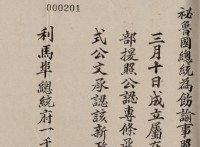
|
Documents on the International Recognition of the Republic of China
Date: 1913
28.3 × 21 cm |
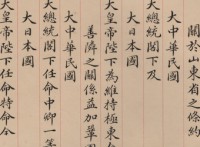
|
Treaty respecting the Province of Shantung between the Republic of China and Japan
Treaty respecting Southern Manchuria and Eastern Inner Mongolia between the Republic of China and Japan
(commonly known as 'the Twenty-One Demands' )
Treaty signed: 1915/5/25
Location: Peking
40 × 29.8 cm |
The treaties in which Japan demands all the original German rights in Shantung Province, and the Chinese government is forced to accept the expansion of Japanese influence into Southern Manchuria and Inner Mongolia.
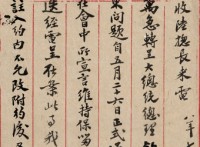
|
Telegrams on ROC's Refusal to Sign the Treaty of Versailles
Date: 1919
28.5 × 20.5 cm |
The ROC Delegation to the Paris Conference reports on the unsuccessful effort to secure Chinese rights on Shantung Province and its decision on the refusal to sign the Treaty of Versailles.
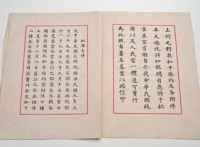
|
Treaty of Peace between the Allied and Associated Powers and Austria
(Treaty of Saint-Germain-en-Laye)
Treaty signed: 1919/9/10
Location: Saint-Germain-en-Laye
44 × 32 cm |
The peace treaty signed after World War I between Austria and the Allied Powers, including the Republic of China.

|
Treaty of Peace between the Allied and Associated Powers and Hungary
(Treaty of Trianon)
Treaty signed: 1920/6/4
Location: Trianon Palace
44 × 32 cm |
The peace treaty signed after World War I between Hungary and the Allied Powers, including the Republic of China.
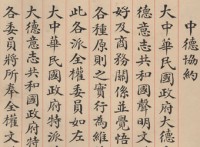
|
Sino-German Agreement
Treaty signed: 1921/5/20
Location: Peking
40.7 × 30.1 cm |
The first bilateral equal treaty since the establishment of the Republic of China.
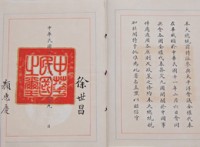
|
Treaty between the United States of America, Belgium, the British Empire, China, France, Italy, Japan, the Netherlands, and Portugal relating to Principles and Policies to be Followed in Matters concerning China
(The Nine-Power Treaty)
Treaty signed: 1922/2/6
Location: Washington, D.C.
36.8 × 27.2 cm |
A treaty giving international acknowledgment to respect the sovereignty, independence, and the territorial integrity of the Republic of China.

|
Treaty regulating Tariff Relations between the Republic of China and the United States of America
(Sino-American New Tariff Treaty)
Treaty signed: 1928/7/25
Location: Peiping
37.3 × 27.1 cm |
The first treaty reinstating Chinese tariff autonomy after the unification of China by the Nationalist Government.

|
An Agreement between China and Belgium regarding the Rendition of the Belgian Concession in Tientsin
Agreement signed: 1929/8/31
Location: Tientsin
40.8 × 28 cm |
The first agreement on the retrocession of concession after the unification of China by the National Government.

|
Convention between China and Great Britain for the Rendition of Weihaiwei and Agreement regarding Certain Facilities for British Navy after Rendition
Agreement signed: 1930/4/8
Location: Nanking
Convention 36.2 × 25.9 cm
Agreement 36.2 × 25.9 cm |
The first convention on the retrocession of Leased Territory after the unification of China by the National Government.
New Treaties of Equality
Dr. Sun Yat-sen, the Founding Father of the Republic of China (ROC), remained highly concerned about the unequal treaties that shackled the nation even on his deathbed. He urged his fellow countrymen in his last will and testament,'...the abrogation of unequal treaties should be carried into effect with the least possible delay. This is my solemn charge to you.'
Based on the ideals of Dr. Sun Yat-sen and the progress of the Northern Expedition, the National Government started in 1927 to seek the retrocession of foreign concessions and international settlements at treaty ports along the coast. It also strove to regain the autonomy of tariff-duty management, and to actively conclude new equal treaties with foreign powers. This endeavour was interrupted by the outbreak of the War of Resistance against Japan (a.k.a. the Sino-Japanese War of 1937).
With the eruption of the Pacific War at the end of 1941, the ROC played a heroic and colossal role in the fight against the Japanese and gradually rose to become one of the world's Big Four. This development also helped accelerate the National Government's negotiations with other nations for the annulment of various special privileges they enjoyed in China. On January 11, 1943, the government signed the Treaty for the Relinquishment of Extraterritorial Rights in China and the Regulation of Related Matters with the United States (a.k.a. the Sino-American New Equal Treaty), and with the United Kingdom (a.k.a. the Sino-British New Equal Treaty), respectively, in Washington, D.C., and Chungking. This marked the beginning of the end of the era of unequal treaties, and set a milestone in the efforts for their abrogation.
Belgium, Norway, Canada, Sweden, the Netherlands, France, Switzerland, Denmark and Portugal soon followed suit by signing equal treaties with the Republic of China, relinquishing a wide range of special privileges, such as extraterritoriality, unilateral most-favoured-nation treatment and inland navigation rights. The Republic of China finally rid itself of the hundred years of shackles and fulfilled the last wish and testament of Dr. Sun Yat-sen.
To celebrate the signing of the new equal treaties with the United States and the United Kingdom, the National Government proclaimed January 11 as'Justice Day', and February 5-7, 1943, as a three-day national holiday. Throughout the country people could be heard singing the'Song in Celebration of the New Equal Treaties'. The ROC government also issued a set of six stamps in commemoration of new equal treaties on July 7, 1945.

|
Treaty between the Republic of China and the United States of America for the Relinquishment of Extraterritorial Rights in China and the Regulation of Related Matters
(Sino-American New Equal Treaty)
Treaty signed: 1943/1/11
Location: Washington, D.C.
33.8 × 25.6 cm |

|
Treaty between the Republic of China and the United Kingdom and India for the Relinquishment of Extraterritorial Rights in China and the Regulation of Related Matters
(Sino-British New Equal Treaty)
Treaty signed: 1943/1/11
Location: Chungking
35 × 25.6 cm |

|
Treaty between the Republic of China and the Belgium-Luxembourg Economic Union for the Rel inquishment of Extraterritorial Rights in China and the Regulation of Related Matters
(Sino-Belgian New Equal Treaty)
Treaty signed: 1943/10/20
Location: Chungking
35 × 25.2 cm |
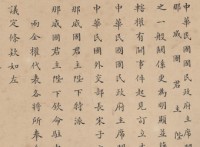
|
Treaty between the Republic of China and the Kingdom of Norway for the Relinquishment of Extraterritorial Rights in China and the Regulation of Related Matters
(Sino-Norwegian New Equal Treaty)
Treaty signed: 1943/11/10
Location: Chungking
36.3 × 26.7 cm |

|
Treaty between the Republic of China and Canada concerning the Relinquishment of Extraterritorial Rights and the Regulation of Related Matters
(Sino-Canadian New Equal Treaty)
Treaty signed: 1944/4/14
Location: Ottawa
38.3 × 26 cm |

|
Treaty between the Republic of China and the Kingdom of Sweden for the Relinquishment of Extraterritorial and Related Special Rights in China
(Sino-Swedish New Equal Treaty)
Treaty signed: 1945/4/5
Location: Chungking
35.3 × 25.4 cm |

|
Treaty between the Republic of China and the Kingdom of the Netherlands for the Relinquishment of Extraterritorial Rights in China and the Regulation of Related Matters
(Sino-Dutch New Equal Treaty)
Treaty signed: 1945/5/29
Location: London
33 × 20.5 cm |
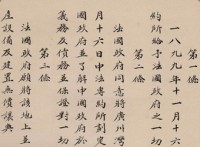
|
Convention between the National Government of the Republic of China and the Provisional Government of the French Republic for the Return of the Leased Territory of Kuang-Chou-Wan
Convention signed: 1945/8/18
Location: Chungking |
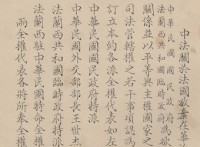
|
Treaty between the National Government of the Republic of China and the Provisional Government of the French Republic for the Relinquishment of Extraterritorial Rights in China and the Regulation of Related Matters
(Sino-French New Equal Treaty)
Treaty signed: 1946/2/28
Location: Chungking
36.3 × 26.3 cm |
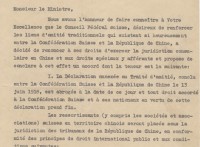
|
Exchange of Notes between the Republic of China and the Swiss Confederation for the Relinquishment of Consular Jurisdiction and Other Special Rights in China
(Sino-Swiss New Equal Treaty)
Date of Exchange: 1946/3/13
Location: Berne
29.7 × 21 cm |
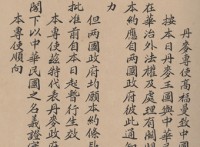
|
Treaty between the Republic of China and the Kingdom of Denmark for the Relinquishment of Extraterritorial Rights in China and the Regulation of Related Matters
(Sino-Danish New Equal Treaty)
Treaty signed: 1946/5/20
Location: Nanking
36.3 × 26.1 cm |
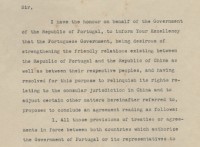
|
Exchange of Notes for the Relinquishment by Portugal of Its Rights relating to the Consular Jurisdiction in China and the Adjustment of Certain Other Matters
(Sino-Portuguese New Equal Treaty)
Date of Exchange: 1947/4/1
Location: Nanking
33.1 × 21.7 cm |
Retrocession of Taiwan
On December 9, 1941, the government of the Republic of China (ROC) officially declared war on Japan, Germany and Italy. The ROC Declaration of War against Japan states that 'all treaties, agreements and contracts concerning Sino-Japanese relations are hereby annulled.'
The Cairo Declaration, agreed upon on November 27, 1943, by the leaders of the Republic of China, the United States and the United Kingdom, and issued, as arranged, by the White House on December 1, states: 'All the territories Japan has stolen from the Chinese, such as Manchuria, Formosa and the Pescadores, shall be restored to the Republic of China.'
The Potsdam Declaration of July 1945 reiterates that the terms of the Cairo Declaration shall be carried out. On August 15 that same year, the Japanese Emperor announced Japan's acceptance of the Potsdam Declaration and its unconditional surrender to the Allies. The Japanese Instrument of Surrender, which was submitted to the Allies and the China Theatre of War on September 2 and 9, respectively, states that Japan accepted the provisions of the Potsdam Declaration. General Order No. 1, issued on September 2 by General Douglas MacArthur, Supreme Commander of the Allied Forces, stipulates that 'the senior Japanese commanders and all ground, sea, air and auxiliary forces within China (excluding Manchuria), Formosa and French Indo-China north of 16° north latitude shall surrender to Generalissimo Chiang Kai-shek.'
These documents provide solid evidence of the retrocession of Taiwan to the Republic of China. Furthermore, the United States also includes both the Cairo Declaration and the Potsdam Declaration as part of the Treaties and Other International Agreements of the United States of America, 1776-1949 and lists the Japanese Instrument of Surrender in the United States Statutes at Large, Vol.59, which makes them binding.
The Treaty of Peace of between the Republic of China and Japan, signed in April 1952, confirms not only the provisions of the above documents, but also the fact that all the inhabitants of Taiwan (Formosa) and Penghu (the Pescadores) hold the nationality of the Republic of China.
This section exhibits five important documents that relate closely to Taiwan. The Treaty of Shimonoseki, an unequal treaty forced upon the Ch'ing Empire, as well as the Cairo Declaration, the Potsdam Declaration and the Treaty of Peace between the Republic of China and Japan, all offer tangible evidence of the ROC's heroic struggle for the successful recovery of its sovereign rights.

|
Treaty of Peace between China and Japan
(Treaty of Shimonoseki)
Treaty signed: 1895/4/17
Location: Shimonoseki
32.3 × 21.8 cm |
The treaty that cedes Taiwan and the Pescadores to Japan.
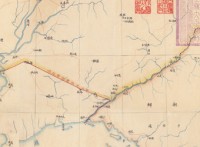
|
Map Attached to the Treaty of Peace between China and Japan
Date:1895/4/17
55 × 68 cm |
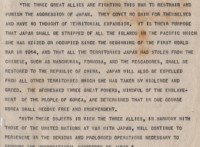
|
Cairo Declaration
Date: 1943/12/1
Location: Washington, D.C.
30.2 × 22.4 cm |
'All the territories Japan has stolen from the Chinese, such as Manchuria, Formosa, and the Pescadores, shall be restored to the Republic of China.'
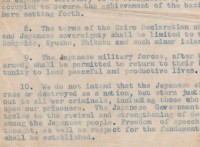
|
Potsdam Declaration
Date: 1945/7/26
Location: Potsdam
30.2 × 22.4 cm |
Article 8:
The terms of the Cairo Declaration shall be carried out and Japanese sovereignty shall be limited to the islands of Honshu, Hokkaido, Kyushu, Shikoku and such minor islands as we determine.
|
|
Japanese Instrument of Surrender to the China Theatre of War
Date: 1945/9/9
Location: Nanking
31.5 × 24 cm |

|
Treaty of Peace between the Republic of China and Japan
(Sino-Japanese Peace Treaty)
Treaty signed: 1952/4/28
Location: Taipei
35.4 × 25.7 cm |
'It is recognized that all treaties, conventions and agreements concluded before December 9, 1941, between Japan and China have become null and void as a consequence of the war.'
Era of Resilience
After the government relocated to Taiwan in 1949, the country faced many daunting challenges and diplomatic setbacks, yet remained resilient and unfazed. Initially, the government worked to safeguard its seat in the United Nations and to maintain relations with its diplomatic allies. Its next main focus was to obtain aid from its allies, and ensure the security and stability necessary for the development of Taiwan, Penghu, Kinmen and Matsu.
The first diplomatic victory of the Republic of China (ROC) on Taiwan occurred after it made a formal complaint to the United Nations, in 1949, against the Soviet Union for violating China's territorial integrity, which led to the loss of the mainland by the legitimate government of the ROC to the Chinese Communists. After three years, UN Resolution 505 was adopted on February 1, 1952, with 25 votes in favour, 9 against, 24 abstaining, and 2 in absentia. The resolution meant that the Chinese Communists had no right to enter the United Nations, and the ROC was able to keep its UN membership for two more decades.
When reading out the countr y's strong case before the world body, Dr. Tsiang Ting-fu, then ROC permanent representative to the UN, spoke for 2 hours and 45 minutes. His speech is one of the longest and most influential documents in the history of our foreign relations.
Twenty documents are on display in this section: the Sino-American Mutual Defense Treaty of 1954 that guaranteed Taiwan's security, as well as archival materials that show our efforts towards enhancing foreign relations, through flexible approaches, after our withdrawal from the United Nations. These range from the promotion of substantive relations and economic and trade diplomacy with other nations, to participation in international human rights and health matters.
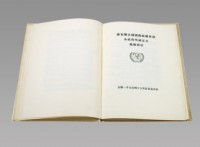
|
Interim Arrangements Concluded by the Governments Represented at the United Nations Conference on International Organization
Agreement signed: 1945/6/26
Location: San Francisco
35 × 26.2 cm |
The Republic of China is one of the founding members of the United Nations.

|
Treaty of Friendship and Alliance between the Republic of China and the Union of Soviet Socialist Republics
Treaty signed: 1945/8/14
Location: Moscow
36.8 × 26.7 cm |
A treaty nullified by the government of the Republic of China on February 25, 1953.

|
Treaty of Friendship, Commerce and Navigation between the Republic of China and the United States of America
(Sino-American Treaty of Commerce)
Treaty signed: 1946/11/4
Location: Nanking
35.3 × 25.7 cm |
The keystone of Sino-American bilateral trade and commerce.
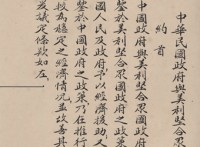
|
Economic Aid Agreement between the Republic of China and the United States of America
(Sino-American Economic Aid Agreement)
Agreement signed: 1948/7/3
Location: Nanking
36.1 × 27 cm |
The basic document for the United States to provide economic aid to the Republic of China.

|
Exchange of Notes constituting the Agreement between the Government of the Republic of China and the Government of the United States of America on the Establishment of a Joint Commission on Rural Reconstruction in China
Date of exchange: 1948/8/5
Location: Nanking
32 × 20.5 cm |
The document lays a solid foundation for Taiwan's booming agricultural development.
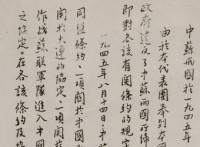
|
Document on 'CHINA PRESENTS HER CASE TO THE UNITED NATIONS ' and the Voting Record of UN Resolution 505
Date: 1952
Location: New York
36.3 × 22.2 cm |
The first diplomatic success after the Republic of China government relocates to Taiwan that enables ROC to keep its UN membership for two more decades.
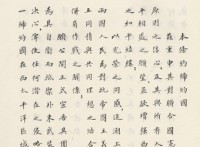
|
Mutual Defense Treaty between the Republic of China and the United States of America
(Sino-American Mutual Defense Treaty)
Treaty signed: 1954/12/2
Location: Washington, D.C.
35.3 × 25.5 cm |
This treaty safeguards the peace, security, and defense of the Taiwan Strait during the Cold War era, but was terminated on December 16, 1979.

|
Agreement between the Republic of China and the United States of America on the Status of United States Armed Forces in the Republic of China
Agreement signed: 1965/8/31
Location: Taipei
36.2 × 26.2 cm |
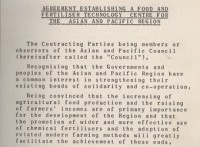
|
Agreement Establishing a Food and Fertiliser Technology Centre for the Asian and Pacific Region
Agreement signed: 1969/6/11
Location: Kawana
34.9 × 24.3 cm |
The first case in which an important regional organization is established in Taiwan.

|
Charter of the Asian Vegetable Research and Development Center
Date: 1971/5/22
Location: Taipei
27.2 × 21 cm |
A joint agreement signed by the Republic of China, the United States of America, Japan, Korea, the Philippines, Thailand, Vietnam, and the Asian Development Bank to set up the Asian Vegetable Research and Development Center at Shanhua, Tainan, Taiwan.

|
The Republic of China's Announcement on Its Withdrawal from the United Nations
Date: 1971/10/25
Location: New York
28.3 × 22 cm |

|
Agreement on the Establishment of Offices between the Association of East Asian Relations and the Interchange Association
Agreement signed: 1972/12/26
Location: Taipei
36.2 × 26.2 cm |
The first agreement the Republic of China signs with countries lacking diplomatic relations on the establishment of representative offices.

|
Agreement on Privileges, Exemptions and Immunities between the Coordination Council for North American Affairs and the American Institute in Taiwan
Agreement signed: 1980/10/2
Location: Washington, D.C.
36.5 × 22.8 cm |
The first agreement the Republic of China signs with countries lacking diplomatic relations on functional exemptions, privileges, and immunities for each other’s representative offices and personnel.
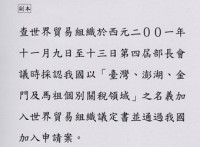
|
General Agreement on Tariffs and Trade (GATT) Council Letter of Invitation
Date: 1992/10/1
38.2 × 27.9 cm
The beginning of the Republic of China's reentry into the multilateral trade system.
World Trade Organization (WTO) Protocol of Accession of the Separate Customs Territory of Taiwan, Penghu, Kinmen and Matsu
Date: 2001/12/2
38.2 × 27.9 cm
The Republic of n a participates in the most important multilateral trade organization after years of persistent endeavour.
Instrument of Accession for 'The Government Procurement Agreement (GPA) of the World Trade Organization'
Date: 2009/6/8
36.5 × 26.8 cm
The innovative document that makes foreign government procurement tenders available to Taiwan's businessmen. |
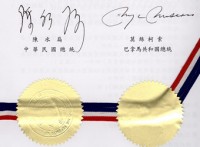
|
Free Trade Agreement between the Republic of China and the Republic of Panama
Agreement signed: 2003/8/21
Location: Taipei
36 × 25.7 cm |
The first free trade agreement the ROC signs with foreign countries.
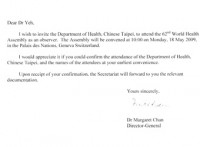
|
World Health Assembly (WHA) Letter of Invitation
Date: 2009/4/28
Location: Geneva
29.7 × 21 cm |
The Republic of China's participation, for the first time, in a meeting of a UN specialised agency since the ROC's withdrawal from the United Nations, in this case as an observer.
Instruments of Ratification for 2 UN International Covenants on Human Rights
|
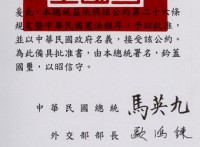
|
Instrument of Ratification for the International Covenant on Economic, Social and Cultural Rights
Instrument of Ratification Signed: 2009/5/14
36.4 × 26.7 cm |
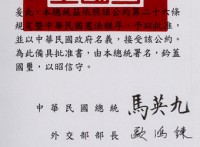
|
Instrument of Ratification for the International Covenant on Civil and Political Rights
Instrument of Ratification Signed: 2009/5/14 |
Diplomatic Legacy
After defeat by the joint British and French forces in 1860, the Ch'ing imperial court set up the Tsung-li yamen (Office of Foreign Affairs) on March 11, 1861, the first such institution in China's modern history.
As dictated by the foreign powers, the Ch'ing dynasty renamed this office the Waiwu pu (Ministry of External Affairs) on July 24, 1901, which took precedence over the other six ministries. This change was clearly recorded in the Boxer Protocol signed on September 7 that year.
When the Republic of China was established in 1912, Provisional President Sun Yat-sen designated Wang Chung-hui as its first foreign minister. When the government relocated to Peking in March that year, Lou Tseng-Tsiang then took over the office. On April 8, 1913, Brazil and Peru became the first countries to formally recognise the Republic of China.
Before the government of the Republic of China relocated to Taipei in 1949, the Ministry of Foreign Affairs carefully shipped most of its archives and documents, including those from the Tsung-li ya-men and the Waiwu pu, to Taiwan. The number of files in the archives has increased exponentially over the years, making it a treasure trove for the study of modern diplomatic history.

|
Imperial Decree to Establish the Tsung-li ya-men (Office of Foreign Affairs)
Court Diary Volumes
Date: 1861/1/20
33.5 × 18.8 cm |
The first government agency established by the Ch'ing Court to deal with foreign countries on an equal basis.

|
Appointment Document for Minister Wang Chung-hui, the First Foreign Minister of the Republic of China
Date of appointment: 1912/1/5
Location: Nanking
32 × 41.4 cm |
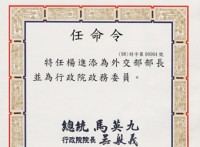
|
Appointment Document for Minister Timothy Chin-tien Yang, the Current Foreign Minister of the Republic of China
Date of appointment: 2009/9/10
Location: Taipei
35.3 × 26.3 cm |
Text and images are provided by National Palace Museum
|



































![Map of the Extension of the British Concession at Sun-on [Hsin-an] Hsien, Kuangtung Province](http://culture.teldap.tw/culture/plugins/content/fboxbot/thumbs/diplomatic29_200x147_052dbe2bb0cf301cbb0ff1ad09010ac5.jpg)

































































